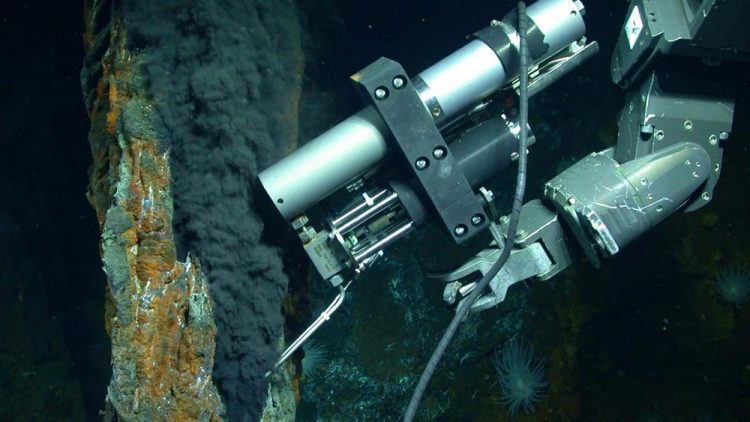Origin of massive methane reservoir identified

The manipulator arm of the remotely operated vehicle Jason samples a stream of fluid from a hydrothermal vent. The fluid contains gases that are in liquid form because of the high pressure of the deep ocean. Credit: Photo by Chris German/WHOI/NSF, NASA/ROV Jason 2012, © Woods Hole Oceanographic Institution
“Identifying an abiotic source of deep-sea methane has been a problem that we've been wrestling with for many years,” says Jeffrey Seewald a senior scientist at WHOI who studies geochemistry in hydrothermal systems and is one of the study's authors.
Of 160 rock samples analyzed from across the world's oceans, almost all contained pockets of methane. These oceanic deposits make up a reservoir exceeding the amount of methane in Earth's atmosphere before industrialization, estimates Frieder Klein, a marine geologist at WHOI and lead author of the study.
“We were totally surprised to find this massive pool of abiotic methane in the oceanic crust and mantle,” Klein says.
The scientists analyzed rocks using Raman spectroscopy, a laser-based microscope that allows them to identify fluids and minerals in a thin slice of rock. Nearly every sample contained an assemblage of minerals and gases that form when seawater, moving through the deep oceanic crust, is trapped in magma-hot olivine.
As the mineral cools, the water trapped inside undergoes a chemical reaction, a process called serpentinization that forms hydrogen and methane. The authors demonstrate that in otherwise inhospitable environments, just two ingredients?–water and olivine?–can form methane.
“Here's a source of chemical energy that's being created by geology,” says Seewald.
On Earth, deep-sea methane might have played a critical role for the evolution of primitive organisms living at hydrothermal vents on the seafloor, Seewald explains. And elsewhere in the solar system, on places like Jupiter's moon Europa and Saturn's Enceladus, methane produced through the same process could provide an energy source for basic life forms.
###
The Woods Hole Oceanographic Institution is a private, non-profit organization on Cape Cod, Mass., dedicated to marine research, engineering, and higher education. Established in 1930 on a recommendation from the National Academy of Sciences, its primary mission is to understand the oceans and their interaction with the Earth as a whole, and to communicate a basic understanding of the oceans' role in the changing global environment. For more information, please visit http://www.
Media Contact
All latest news from the category: Earth Sciences
Earth Sciences (also referred to as Geosciences), which deals with basic issues surrounding our planet, plays a vital role in the area of energy and raw materials supply.
Earth Sciences comprises subjects such as geology, geography, geological informatics, paleontology, mineralogy, petrography, crystallography, geophysics, geodesy, glaciology, cartography, photogrammetry, meteorology and seismology, early-warning systems, earthquake research and polar research.
Newest articles

High-energy-density aqueous battery based on halogen multi-electron transfer
Traditional non-aqueous lithium-ion batteries have a high energy density, but their safety is compromised due to the flammable organic electrolytes they utilize. Aqueous batteries use water as the solvent for…

First-ever combined heart pump and pig kidney transplant
…gives new hope to patient with terminal illness. Surgeons at NYU Langone Health performed the first-ever combined mechanical heart pump and gene-edited pig kidney transplant surgery in a 54-year-old woman…

Biophysics: Testing how well biomarkers work
LMU researchers have developed a method to determine how reliably target proteins can be labeled using super-resolution fluorescence microscopy. Modern microscopy techniques make it possible to examine the inner workings…





















